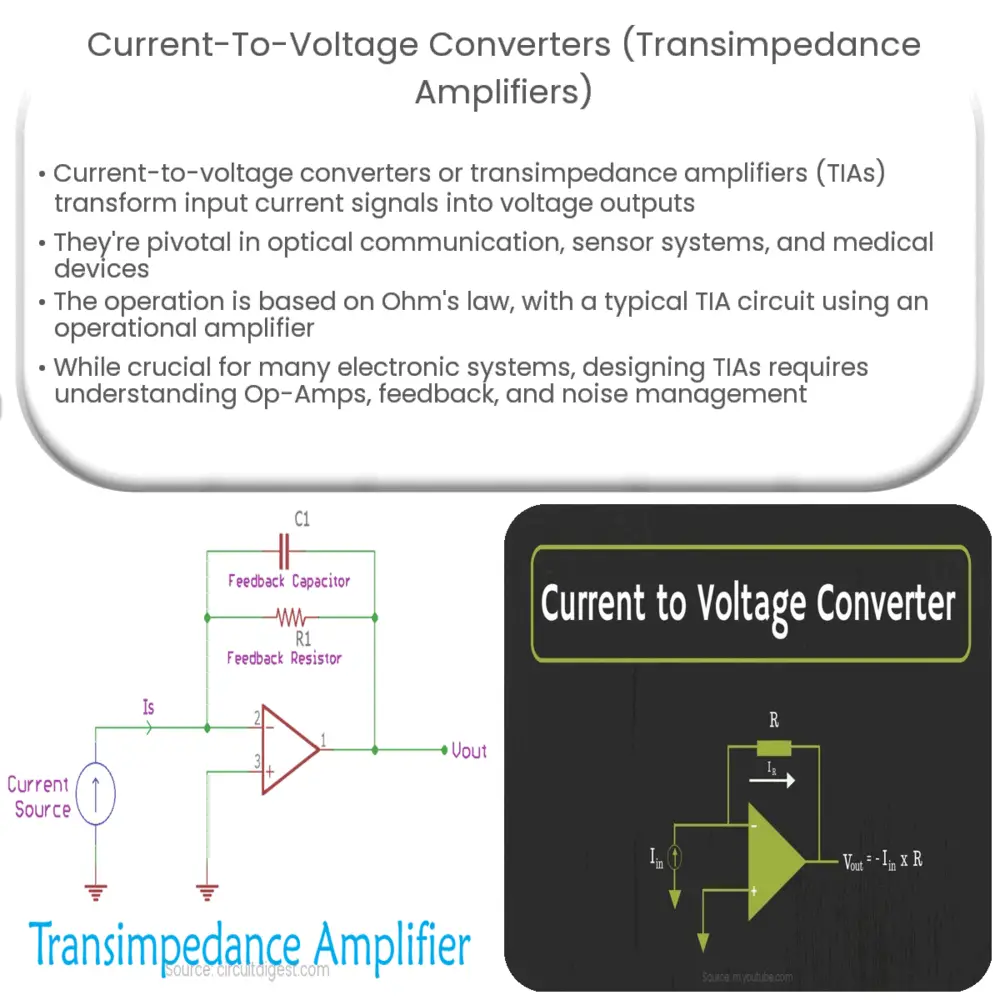Explore the world of Transimpedance Amplifiers (TIAs), their working principles, key characteristics, applications, design considerations, and challenges.

Introduction to Current-to-Voltage Converters
Current-to-voltage converters, also known as transimpedance amplifiers (TIAs), are specialized devices used in electronic systems to convert an input current signal into an output voltage signal. TIAs are an integral component in many applications including optical communication, sensor systems, and medical instrumentation. They are particularly useful when dealing with signals from photodiodes, where the response to light is a current which needs to be converted into a voltage to be further processed.
Working Principle of a Transimpedance Amplifier
The basic working principle of a TIA is underpinned by Ohm’s law (V=I*R), which states that voltage is the product of current and resistance. TIAs leverage this principle to produce an output voltage proportional to the input current, where the constant of proportionality is the amplifier’s transimpedance gain. A typical TIA circuit involves an operational amplifier (Op-Amp) in a negative feedback configuration, where the input current is applied to the inverting input of the Op-Amp, and the feedback element is a resistor.
Key Characteristics of a Transimpedance Amplifier
- Transimpedance Gain: The TIA’s gain determines how much the input current will be amplified when converted into a voltage signal. This gain is typically represented by the feedback resistor (Rf) in the TIA circuit.
- Noise Performance: As with any amplifier, noise is an important consideration. In the case of TIAs, the key sources of noise include thermal noise (also known as Johnson noise), shot noise, and amplifier noise.
- Bandwidth: The bandwidth of a TIA refers to the range of frequencies over which it can accurately convert current into voltage. It is a key determinant of the speed at which the TIA can operate.
Applications of Transimpedance Amplifiers
- Optical Communication: TIAs play a crucial role in optical communication systems, where they are used to convert current produced by photodiodes into a usable voltage signal.
- Sensor Systems: In sensor systems, TIAs convert current outputs from sensors into voltage signals that can be read and processed by other electronics.
- Medical Instrumentation: In medical devices, TIAs are often used in the signal processing stage to convert bioelectrical currents into voltage signals.
Design Considerations for Transimpedance Amplifiers
In designing TIAs, several factors need to be considered to ensure optimal performance. These include the selection of the appropriate operational amplifier and the choice of the feedback resistor value.
- Selection of Operational Amplifier: The choice of the Op-Amp used in the TIA circuit has a significant impact on the performance of the TIA. Important parameters include the input bias current, input offset voltage, and the amplifier’s bandwidth.
- Feedback Resistor Value: The feedback resistor determines the transimpedance gain of the amplifier. Its value is selected based on the desired output voltage level for a given input current.
Challenges and Solutions
While TIAs provide significant benefits, they are not without their challenges. One such challenge is stability. Since TIAs typically operate in a negative feedback configuration, there’s a risk of oscillation. Proper compensation techniques, such as adding a small capacitor in parallel with the feedback resistor, are often used to improve stability.
Another challenge is noise performance. As mentioned earlier, TIAs generate several types of noise. Various techniques are employed to minimize this noise, including careful selection of the Op-Amp and feedback resistor, and the use of noise reduction techniques like shielding and signal conditioning.
Conclusion
In summary, transimpedance amplifiers are crucial in various domains, transforming input current signals into output voltage signals. Understanding their working principle, key characteristics, and potential applications enables us to appreciate their role in the field of electronics. However, designing a TIA necessitates a deep understanding of Op-Amps, feedback mechanisms, and noise management. Despite the associated challenges, the value of TIAs in enhancing the precision and efficiency of electronic systems cannot be overstated. As technology continues to advance, we can expect the role of TIAs to become even more critical, necessitating further research and development in this field.

